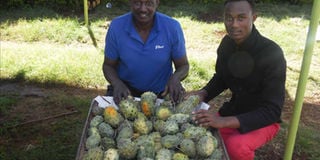Grow this thorny melon, its returns don’t hurt my wallet

Kenneth Kimanthi on his farm in Meru after harvesting thorn melons. The fruit has an array of uses. PHOTO | CAROLINE WAMBUI | NATION MEDIA GROUP
What you need to know:
- Thorn melon is a climber thus requires trellis.The fruit, which is also known as Kiwano, horned melon or melano, is famous for numerous benefits that include its ability to improve cognitive ability, strengthen bones, boost metabolism and eye health, aid in weight loss, protects the skin, optimises digestion and speeds up wound healing.
- The farmer plants the seeds directly into the field where he first applies animal manure.
- The fruit requires warm to hot climatic conditions and he plants it in two seasons, the first is between October and January and between March and July.
Ntharene market in Meru is arguably the biggest banana selling point in the agriculture-rich county.
Hundreds of traders congregate every day at this market exchanging the produce with both retailers and wholesalers.
And near the popular market sits Daja Farm owned by Kenneth Kimanthi. As many other residents, Kimanthi farmed bananas thanks to the convenient market, but an encounter with a trader who had visited his farm to buy the produce made his shift from the crop.
“He saw several thorn melon plants that were growing at a compost heap on my farm and enquired if I also farmed the crop. I had no idea what it was then and told him it was a weed growing on its own,” recounts Kimanthi, 50, noting the trader informed him the fruit fetches good prices.
Further research showed him that thorn melon has numerous benefits and was selling at Sh20 a piece. The teacher at Kagaru Primary School collected about 300 seeds from the existing fruits, dried them and planted on part of his five acres.
“The seeds sprouted after seven days and matured in about six months, with management entailing mainly weeding. I harvested close to 500 fruits and sold them at Ntharene market at Sh20 each,” he says.
Since then, he has expanded and mastered the art of growing the crop that he now intercrops it with maize and sunflower.
“I farm the crop on three acres and use the space even much better due to intercropping.”
Jafford Njeru, a lecturer at the Department of Environmental Studies, Chuka University, explains that through intercropping, the performance of other crops is enhanced, as there is provision of nutrients and shade, which shields the crop from the strong sun rays.
Thorn melon is a climber thus requires trellis, but Kimanthi says he has realised more fruits when the plant is allowed to grow on the ground and act as a cover crop.
He plants the seeds directly into the field where he first applies animal manure.
LABOUR INTENSIVE
“It takes the seedlings about one to one-and-a-half months before they form a covering and mature in six months. One uses a knife to cut and separate the fruit from the stem. The sharp thorns die as the fruit ripens,” he says.
The fruit requires warm to hot climatic conditions and he plants it in two seasons, the first is between October and January and between March and July.
It is susceptible to tobacco ring spot, watermelon mosaic virus and cucumber mosaic virus, among others.
The fruit, which is also known as Kiwano, horned melon or melano, is famous for numerous benefits that include its ability to improve cognitive ability, strengthen bones, boost metabolism and eye health, aid in weight loss, protects the skin, optimises digestion and speeds up wound healing.
Kimanthi sells his melons at Ntharene, Nairobi, Nkubu and Narok markets, where in a good season he fetches up to Sh200,000 from his over 1,000 plants.
According to him, the crop is not labour intensive, making it friendly to the farmer since he weeds once and does not even use pesticides as it is not attacked by pests.
Packing the fruit for the market, however, is one of the challenges he has to contend with.
“Due to its thorny nature, the melon when inappropriately packed bruise each hence damaging the quality. The melon should be packed in single layers in crates. I separate the layers with dry banana leaves which act as a protective pad,” he says.
The fruit is a good source of Vitamin C, potassium and iron. It also has magnesium, phosphorous, zinc, copper, calcium and sodium, and is packed with lots of antioxidants that keep the blood vessel and nerves healthy.
****
How wonder melon is used across the world
The green jelly-like flesh can be taken with little sugar, or with exotic fruit salad. It can also be utilised like an alternative to vinegar in salads.
The fruits are also used for ornamental purposes.
Used in beverages and at times spooned over desserts, ice creams and yoghurts to have an exceptional taste.
Its leaves are medicinal and are often served cooked as the heat is said to slightly lessen the bitterness in the greens.
When cooking, the bitter melon leaves are added last to inhibit an overly bitter taste and can be served with rice. The leaves can also be used in curries, fries and soups.
The leaves are at times mixed with maize or corn meal and can also be used to make a medicinal tea. Younger leaves which have a milder flavour and delicate texture can be used in salads.
In some countries, the leaves are used as an anti-viral for measles and malaria, diabetes, hypertension and to aid in childbirth.
In some cultures, various parts of the bitter melon plant, including the leaves, are used as a contraceptive as they have been shown to have an anti-fertility effect in both males and females.
Boiled roots are also used to treat gonorrhoea in some cultures, according to research.
Decoction of the root is given to women after childbirth for pain relief while in some cultures, the pounded roots are mixed with fat and used to cover the body in the belief that this will





